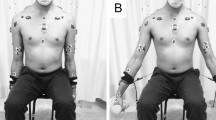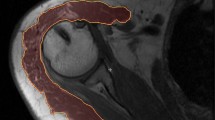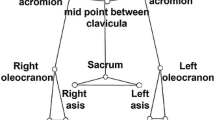Abstract
Rotator cuff (RC) tears have a high prevalence, and RC repair surgery is frequently performed. Evaluation of deltoid activation has been reported as an easy to measure proxy for RC functionality. Our goal was to test the success of RC repair in restoring muscle function, by assessing deltoid activation with varying arm abduction moment loading tasks in controls and in RC tear patients before and 1 year after RC repair. Averaged rectified electromyography recordings (rEMG) of the deltoid during 2-s isometric arm abduction tasks were assessed in 22 controls and 33 patients before and after RC repair. Changes in deltoid activation as a response to increased arm abduction moment loading (large vs. small moment), without changing task force magnitude, were expressed as: R = (rEMGLarge − rEMGSmall)/(rEMGLarge + rEMGSmall), where R > 0 indicates an increase in muscle activation with larger moment loading. In controls, a significant increase in deltoid activation was observed with large abduction moment loading: R = 0.11 (95 % CI 0.06–0.16). In patients, R was larger: 0.20 (95 % CI 0.13–0.27) preoperatively and 0.16 (95 % CI 0.09–0.22) postoperatively. Increased compensatory deltoid activation was found in pre-operative RC tear patients. The post-operative decrease in compensatory deltoid activation, although not significant, could indicate (partially) restored RC function in at least some patients.


Similar content being viewed by others
References
Ackland DC, Pak P, Richardson M, Pandy MG (2008) Moment arms of the muscles crossing the anatomical shoulder. J Anat 213:383–390. doi:10.1111/j.1469-7580.2008.00965.x
Constant CR, Gerber C, Emery RJ, Sojbjerg JO, Gohlke F, Boileau P (2008) A review of the constant score: modifications and guidelines for its use. J Should Elbow Surg 17:355–361. doi:10.1016/j.jse.2007.06.022
de Groot JH, Rozendaal LA, Meskers CG, Arwert HJ (2004) Isometric shoulder muscle activation patterns for 3-D planar forces: a methodology for musculo-skeletal model validation. Clin Biomech (Bristol, Avon) 19:790–800. doi:10.1016/j.clinbiomech.2004.05.013
de Groot JH, van de Sande MA, Meskers CG, Rozing PM (2006) Pathological Teres major activation in patients with massive rotator cuff tears alters with pain relief and/or salvage surgery transfer. Clin Biomech (Bristol, Avon) 21(Suppl 1):S27–S32. doi:10.1016/j.clinbiomech.2005.09.011
de Witte PB, Henseler JF, Nagels J, Vlieland TPV, Nelissen RG (2012) The Western Ontario rotator cuff index in rotator cuff disease patients: a comprehensive reliability and responsiveness validation study. Am J Sports Med 40:1611–1619. doi:10.1177/0363546512446591
Fokter SK, Cicak N, Skorja J (2003) Functional and electromyographic results after open rotator cuff repair. Clin Orthop Relat Res:121–130. doi:10.1097/01.000093903.12372.3f
Gerber C, Blumenthal S, Curt A, Werner CM (2007) Effect of selective experimental suprascapular nerve block on abduction and external rotation strength of the shoulder. J Should Elbow Surg 16:815–820. doi:10.1016/j.jse.2007.02.120
Gorelick ML, Brown JM (2007) Mechanomyographic assessment of contractile properties within seven segments of the human deltoid muscle. Eur J Appl Physiol 100:35–44. doi:10.1007/s00421-007-0397-8
Hansen ML, Otis JC, Johnson JS, Cordasco FA, Craig EV, Warren RF (2008) Biomechanics of massive rotator cuff tears: implications for treatment. J Bone Joint Surg Am 90:316–325. doi:10.2106/JBJS.F.00880
Hawkes DH, Alizadehkhaiyat O, Kemp GJ, Fisher AC, Roebuck MM, Frostick SP (2012) Shoulder muscle activation and coordination in patients with a massive rotator cuff tear: an electromyographic study. J Orthop Res 30:1140–1146. doi:10.1002/jor.22051
Keenan KG, Farina D, Maluf KS, Merletti R, Enoka RM (2005) Influence of amplitude cancellation on the simulated surface electromyogram. J Appl Physiol 98:120–131. doi:10.1152/japplphysiol.00894
Kirkley A, Alvarez C, Griffin S (2003) The development and evaluation of a disease-specific quality-of-life questionnaire for disorders of the rotator cuff: the Western Ontario Rotator Cuff Index. Clin J Sport Med 13:84–92. doi:10.1097/00042752-200303000-00004
Kuechle DK, Newman SR, Itoi E, Morrey BF, An KN (1997) Shoulder muscle moment arms during horizontal flexion and elevation. J Should Elbow Surg 6:429–439. doi:10.1016/S1058-2746(97)70049-1
Mall NA, Kim HM, Keener JD, Steger-May K, Teefey SA, Middleton WD, Stobbs G, Yamaguchi K (2010) Symptomatic progression of asymptomatic rotator cuff tears: a prospective study of clinical and sonographic variables. J Bone Joint Surg Am 92:2623–2633. doi:10.2106/JBJS.I.00506
McCully SP, Suprak DN, Kosek P, Karduna AR (2007) Suprascapular nerve block results in a compensatory increase in deltoid muscle activity. J Biomech 40:1839–1846. doi:10.1016/j.jbiomech.2006.07.010
Meskers CG, de Groot JH, Arwert HJ, Rozendaal LA, Rozing PM (2004) Reliability of force direction dependent EMG parameters of shoulder muscles for clinical measurements. Clin Biomech (Bristol, Avon) 19:913–920. doi:10.1016/j.clinbiomech.2004.05.012
Reilly P, Macleod I, Macfarlane R, Windley J, Emery RJ (2006) Dead men and radiologists don’t lie: a review of cadaveric and radiological studies of rotator cuff tear prevalence. Ann R Coll Surg Engl 88:116–121. doi:10.1308/003588406X94968
San Juan JG, Kosek P, Karduna AR (2012) Humeral head translation after a suprascapular nerve block. J Appl Biomech [Epub ahead of print]
Seida JC, LeBlanc C, Schouten JR, Mousavi SS, Hartling L, Vandermeer B, Tjosvold L, Sheps DM (2010) Systematic review: nonoperative and operative treatments for rotator cuff tears. Ann Intern Med 153:246–255
Sharkey NA, Marder RA, Hanson PB (1994) The entire rotator cuff contributes to elevation of the arm. J Orthop Res 12:699–708
Sher JS, Uribe JW, Posada A, Murphy BJ, Zlatkin MB (1995) Abnormal findings on magnetic resonance images of asymptomatic shoulders. J Bone Joint Surg Am 77:10–15
Sobel JS, Winters JC (1996) Shoulder complaints in general practice. Diagnosis and treatment. PhD Thesis, University of Groningen, Groningen, The Netherlands
Steenbrink F, de Groot JH, Veeger HE, Meskers CG, van de Sande MA, Rozing PM (2006) Pathological muscle activation patterns in patients with massive rotator cuff tears, with and without subacromial anaesthetics. Man Ther 11:231–237. doi:10.1016/j.math.2006.07.004
Steenbrink F, de Groot JH, Veeger HE, van der Helm FC, Rozing PM (2009) Glenohumeral stability in simulated rotator cuff tears. J Biomech 42:1740–1745. doi:10.1016/j.jbiomech.2009.04.011
Steenbrink F, Meskers CG, van Vliet B, Slaman J, Veeger HE, de Groot JH (2009) Arm load magnitude affects selective shoulder muscle activation. Med Biol Eng Comput 47:565–572. doi:10.1007/s11517-009-0482-8
Steenbrink F, Nelissen RG, Meskers CG, van de Sande MA, Rozing PM, de Groot JH (2009) Teres major muscle activation relates to clinical outcome in tendon transfer surgery. Clin Biomech (Bristol, Avon) 25:187–193. doi:10.1016/j.clinbiomech.2009.11.001
Steenbrink F, Meskers CG, Nelissen RG, de Groot JH (2010) The relation between increased deltoid activation and adductor muscle activation due to glenohumeral cuff tears. J Biomech 43:2049–2054. doi:10.1016/j.jbiomech.2010.04.012
van der Zwaal P, Thomassen BJW, Nieuwenhuijse MJ, Lindenburg R, Swen JWA, van Arkel ERA (2013) Clinical outcome in all-arthroscopic versus mini-open rotator cuff repair in small- to medium-sized tears: a randomized controlled trial in 100 patients with one year follow-up. Arthroscopy 29:266–273. doi:10.1016/j.arthro.2012.08.022
Wiertsema SH, Rietberg MB, Hekman KM, Schothorst M, Steultjens MP, Dekker J (2013) Reproducibility of the Dutch version of the Western Ontario Rotator Cuff Index. J Should Elbow Surg 22:165–170. doi:10.1016/j.jse.2012.03.014
Yamaguchi K, Tetro AM, Blam O, Evanoff BA, Teefey SA, Middleton WD (2001) Natural history of asymptomatic rotator cuff tears: a longitudinal analysis of asymptomatic tears detected sonographically. J Should Elbow Surg 10:199–203. doi:10.1067/mse.2001.113086
Acknowledgments
The authors would like to acknowledge J. van der Ploeg and P. Bakkenes (Technical Dept., Leiden University Medical Center, The Netherlands) for their input in developing the experimental setup, J.W.A. Swen for performing some of the surgeries, and L. ter Braak and S. Werner (Faculty of Movement Sciences, VU University, Amsterdam) for performing measurements on the healthy controls. This study is part of a larger project funded by ZonMw, The Netherlands Organization for health research and development (NOW) (grant number 40-00703-98-8564), and the Dutch Arthritis Association (grant number 09-1-303).
Author information
Authors and Affiliations
Corresponding author
Rights and permissions
About this article
Cite this article
de Witte, P.B., van der Zwaal, P., van Arkel, E.R.A. et al. Pathologic deltoid activation in rotator cuff tear patients: normalization after cuff repair?. Med Biol Eng Comput 52, 241–249 (2014). https://doi.org/10.1007/s11517-013-1095-9
Received:
Accepted:
Published:
Issue Date:
DOI: https://doi.org/10.1007/s11517-013-1095-9




